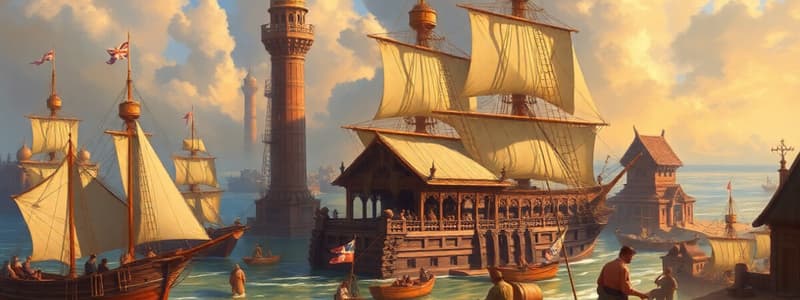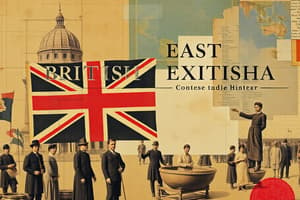Podcast
Questions and Answers
What year did the British East India Company receive its first charter?
What year did the British East India Company receive its first charter?
1599
What year did the British East India Company establish its first factory in Surat?
What year did the British East India Company establish its first factory in Surat?
1608
What year was the Battle of Swally fought?
What year was the Battle of Swally fought?
1612
What city did Thomas Roe visit in 1615?
What city did Thomas Roe visit in 1615?
What year did the British East India Company receive its first monopoly on trade for an indefinite period?
What year did the British East India Company receive its first monopoly on trade for an indefinite period?
Besides Surat, what other cities in India did the British East India Company establish factories by 1633?
Besides Surat, what other cities in India did the British East India Company establish factories by 1633?
Who was the English sea pirate mentioned in the information?
Who was the English sea pirate mentioned in the information?
What country is mentioned as controlling a sea vessel in the information?
What country is mentioned as controlling a sea vessel in the information?
What year is written in the image?
What year is written in the image?
What is the name of the organization that produced this information?
What is the name of the organization that produced this information?
Flashcards
British East India Company
British East India Company
A joint-stock company chartered by the British Crown in 1600, primarily to trade in spices and other goods with the East Indies.
Surat Factory
Surat Factory
The first factory established by the British East India Company in India, located in Surat.
Monopoly on East India Trade
Monopoly on East India Trade
The monopoly granted to the British East India Company by the British Crown in 1600, allowing them exclusive rights to trade with the East Indies.
Battle of Swally
Battle of Swally
Signup and view all the flashcards
Monopoly Extension
Monopoly Extension
Signup and view all the flashcards
Sir Thomas Roe
Sir Thomas Roe
Signup and view all the flashcards
British East India Company Trading Centers
British East India Company Trading Centers
Signup and view all the flashcards
British East India Company Expansion in India
British East India Company Expansion in India
Signup and view all the flashcards
British East India Company's Rise to Power
British East India Company's Rise to Power
Signup and view all the flashcards
British East India Company Era
British East India Company Era
Signup and view all the flashcards
Study Notes
British East India Company: Early History
- The British East India Company was established in 1600
- The company was granted a monopoly on trade in the East for 15 years
- Initial traders were called Merchant Adventurers
- The company's success was partly due to the voyages of Francis Drake (1578), who circumnavigated the globe
- Francis Drake's successful voyage around the world by the Cape Route in 1580 opened opportunities for the East India Company
- 1588 - Historic English victory over the Spanish Armada, which reduced Spanish power and allowed for English expansion
- This victory, along with Drake's voyage, provided a less hostile environment for the company
- The high profits generated by Portuguese trade in the East Indies motivated English traders
- Competition existed with the Dutch in the Spice Islands and Portuguese in India
- Surat, India was a key trade location for the Portuguese
- Captain Hawkins visited the Mughal emperor Jahangir in 1609, but permission to establish a factory was not granted until 1613
- The Battle of Swally, 1612, strengthened English reputation and ensured permission to trade in the Mughal Empire
- In May 1609, King James I extended the company's monopoly of trade in the East for an indefinite period.
- Jahangir granted the English permission to establish a factory in 1613
- English established factories in several significant locations, including Balasore, Masulipatnam, Agra, Ahmedabad, and Broach
- The company faced competition, especially from the Dutch, in the Spice Islands and Portuguese in India, including Surat in India, which was a major Portuguese stronghold.
- Captain Hawkens communicated with the Mughals without an interpreter in the Persian language.
- A commercial treaty between English and Mughal authorities, facilitated by Sir Thomas Roe, who arrived as an ambassador in 1615, secured permission to trade and opened additional factories within the growing Mughal Empire.
Studying That Suits You
Use AI to generate personalized quizzes and flashcards to suit your learning preferences.




